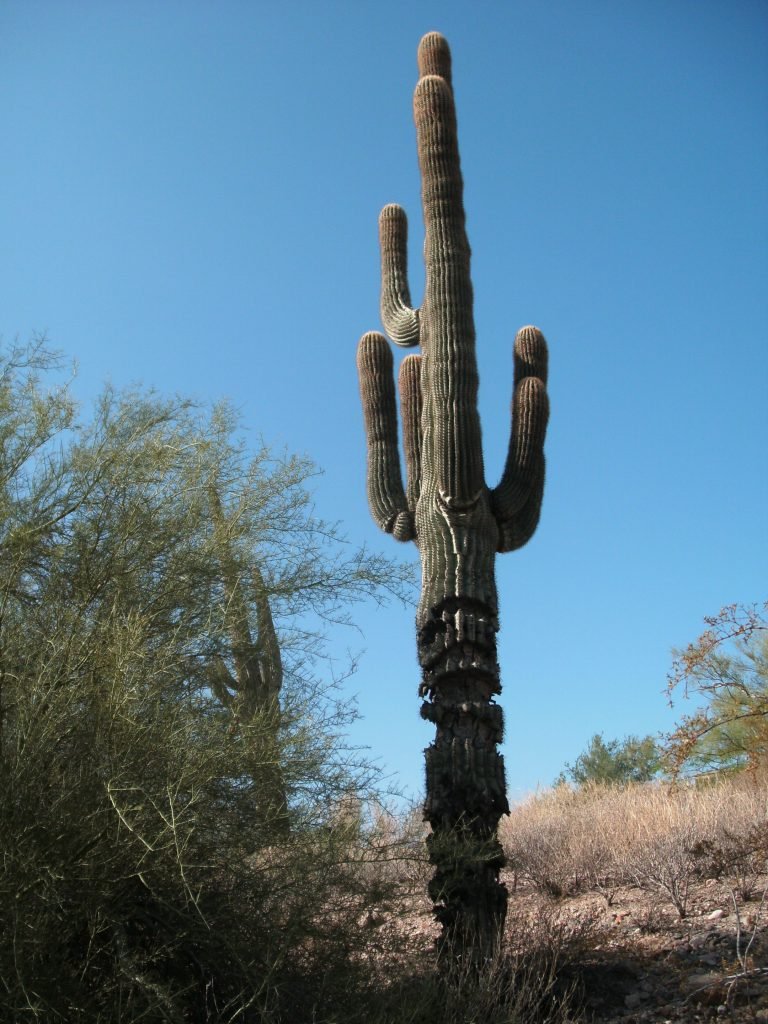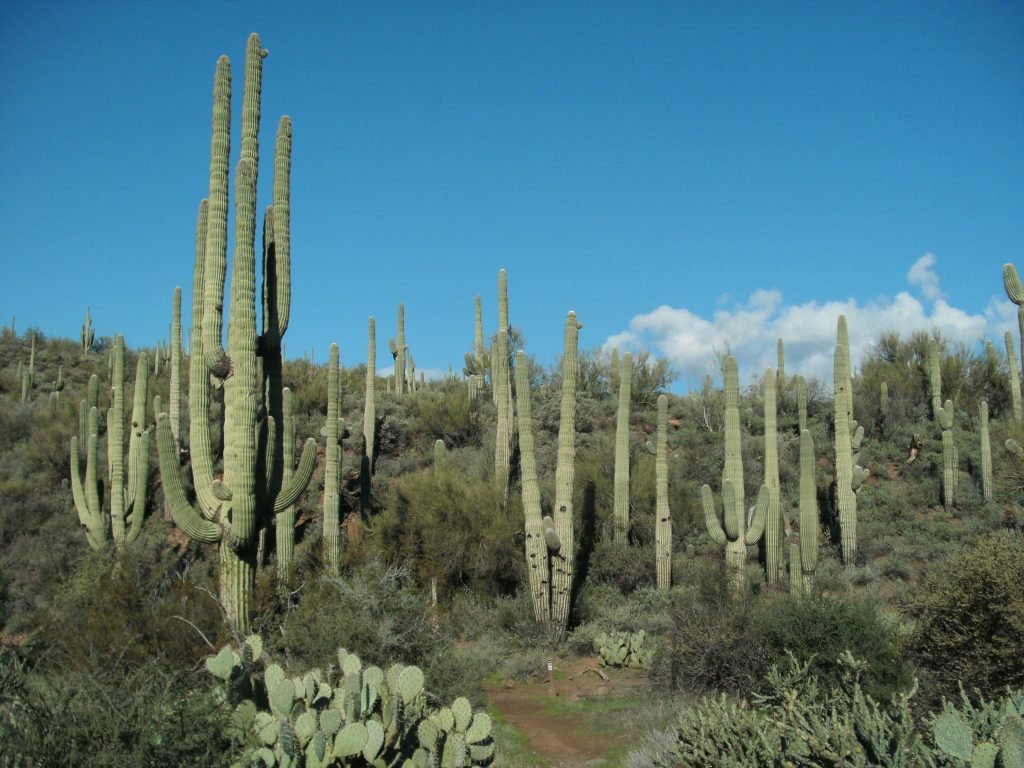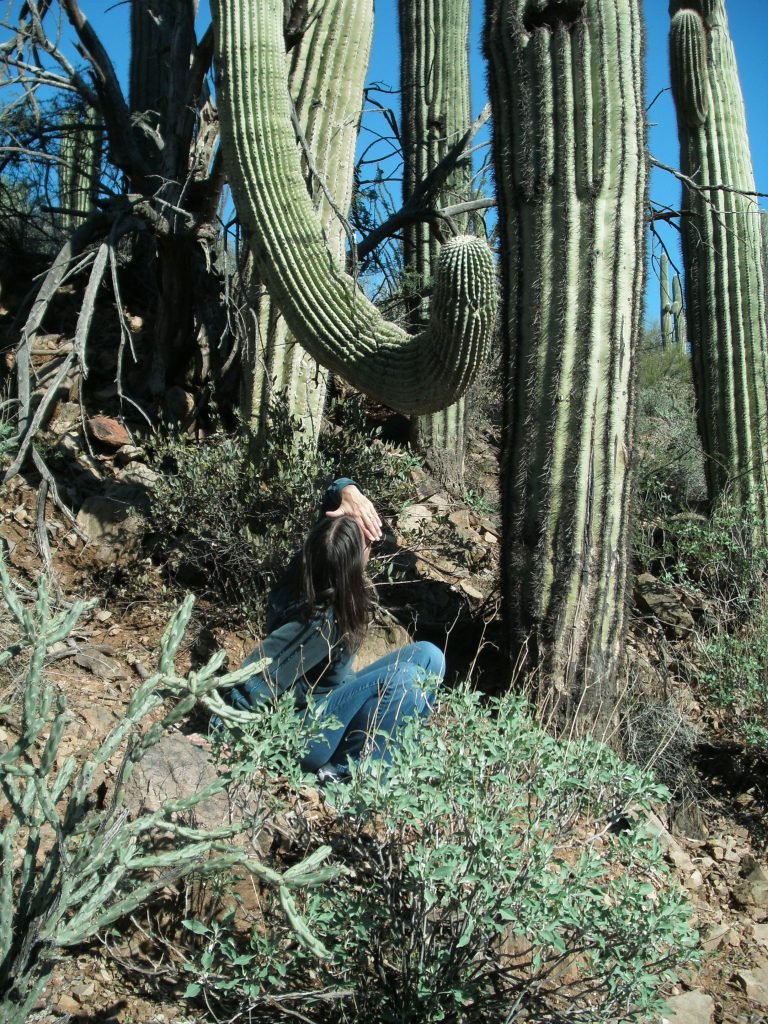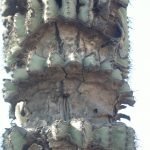from- Swimming with Swans: vignettes of our three year journey between homes
November 2011 (Fountain Hills, AZ)
 During my daily walks along local paths in town and in the surrounding desert area, I’ve noticed Saguaro Cacti with large dark brown “bite” patches along their base up to and including places way high above my head. At first I thought perhaps they were indeed, bites from local fauna that somehow didn’t get hurt eating the spiky spines along with the juicy flesh. Think: deer bites on Aspen tree trunks. But it didn’t seem to fit with the height limit of most animals. So, I got to thinking maybe it was some sort of naturally occurring disease that helps to maintain eco-balance such as the Pine Beetles in the Colorado forests.
During my daily walks along local paths in town and in the surrounding desert area, I’ve noticed Saguaro Cacti with large dark brown “bite” patches along their base up to and including places way high above my head. At first I thought perhaps they were indeed, bites from local fauna that somehow didn’t get hurt eating the spiky spines along with the juicy flesh. Think: deer bites on Aspen tree trunks. But it didn’t seem to fit with the height limit of most animals. So, I got to thinking maybe it was some sort of naturally occurring disease that helps to maintain eco-balance such as the Pine Beetles in the Colorado forests.
I did a bit of Google research and discovered that these dark brown “bite” patches are a result of a variety of causes: freezing, sun-scald, stress and mistreatment in transplanting into urban landscapes from the wild, and last but not least:
Bacterial Necrosis.
Ah.
I found myself repeating the term:
Bacterial Necrosis – Bacterial Necrosis – Bacterial Necrosis
A sort of mantra while walking in and among those Saguaros.
Bacterial Necrosis.
A disease specific to the Saguaro Cactus starting at age 30 or so; soft spots in flesh get stinky, insects invade….
Bacterial Necrosis.
A disease that usually plagues urban Saguaro Cacti due to too much moisture; needs help from the “cactus doctor” to enable its own self-healing process.
Bacterial Necrosis.
In the wild, Saguaro Cacti rarely if ever contract this disease, much less die from it.
In short, the disfigurement and scarring of these plants are a natural part of their life cycle whatever the cause. They continue to grow graceful arms and gain majestic heights to the ripe old age of 200 years, scars and all.
They are the Redwoods of the Desert.
Ah.
I found myself continuing my walks with this mantra in my mind. It wouldn’t let go of me.
Bacterial Necrosis!
Bacterial Necrosis!
Bacterial Necrosis!
There was more for me in this than the biology of the phrase.
Bacterial Necrosis.
More than likely, the scarring I’ve seen on any individual Saguaro Cactus during my walks is the natural result of temperature extremes: freezing then sun-scald, freezing then sun-scald; all part of seasonal cycles within the Sonoran Desert. A forest of Saguaro Cacti with significant disfigurement and scarring due to whatever cause looks like it could be battling some life threatening infestation. In reality it is a magnificent testament to the beauty that can be found while in the midst of affliction.
We all know afflictions are a natural part of our lives. The “stinky” parts of life aren’t forever, though they are often easily seen and judged by others. But then again, the “stinky” parts aren’t usually life threatening. All will heal in time, drawing character lines across physical, emotional and spiritual dimensions.
Bacterial Necrosis.
 When I look upon one of these gentle, yet spiky giants, its scars become part of the whole.
When I look upon one of these gentle, yet spiky giants, its scars become part of the whole.
Bacterial Necrosis.
Thanks to the Saguaro Cacti I walk among most mornings, I can see the truth spoken to me:
“In His time. In His time. He makes all things beautiful in His time.”
…and ‘bacterial necrosis’ makes for a better sounding mantra than ‘freezing sun-scald.’ Wouldn’t you agree?

Such an insightful post, although to me freezing sun-scald doesn’t sound as icky as bacterial necrosis. 🙂
In His time… Ah yes, now that’s a mantra worth repeating!
scarsandlovepeace
That makes for freezing sun-scald – 1, bacterial necrosis – 1
Even Steven.
histimingpeace
Hi Laura, how are you? Interesting article. The lyrics of the song “In His Time He makes all things beautiful,” are so true! Keep well. 🙂 Iris.
That song has been with me for a long time, since its first recording back in the ’70’s. Sometimes, the simple ones are the most heart-touching.
🙂
This was an interesting post. I am so unfamiliar with cactus – except the little ones I had as a kid and they never grew very big before they died. Redwoods of the desert, never thought of them that way either. I think the scarring is like us getting older. We carry the scars of life too, except they live to 200 and we don’t.
Donna:
I learn so much from your nature posts since I am not a native Easterner…it’s nice to know I have some nature insights from my western perspective that I can share with you!
We both seem to glean life-lessons in the natural world and try to pass ’em on to anyone who cares to read about them.
Take care.
peace